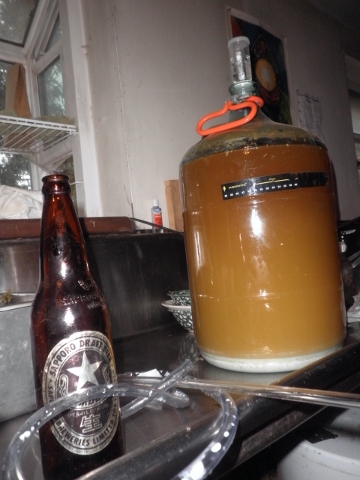Racking the Hard Cider
November 4:
Andrew:
Part of living on our land is finding ways to deal with the seasonal cycles of surplus and shortage.
This year's expedition into apple cider is just one more method for storing and preserving the flush of fall harvest.
the bearing of a single way-side
apple tree in 2008 |
| |
The new cider making operation is a fairly effective way of processing whole apples into a more condensed form. However, even with the fiber removed, there was no way we could store all the cider in our freezers. So we decided to employ an age-old method of food preservation‒fermentation.
a carboy and some supplies |
| |
We broke out the 5 gallon carboys, sanitized them and filled them up with freshly pressed cider. We then added brewer's yeast and plugged the top with a one way water valve to allow CO2 gas to escape, but otherwise seal the vessel.
a graph showing yeast population
over time within a wine vat
the same dynamic is true for
our cider fermentation |
| |
Each batch of Cider sat in our warm earth-sheltered kitchen until it was apparent that the fermentation process was dramatically slowing down. That took about two weeks.
We also used a special instrument, a hydrometer or "saccharometer," to determine the sugar content of the fresh cider.
Hydrometers works by measuring the specific gravity (or relative density) of a liquid: the ratio of its density compared to the density of water at a certain temperature.
The percent sugar of the fresh cider was 13.5%. If 100% of those sugars were transformed by yeast into alcohol, the hard cider would be about 7.5% alcohol. That is definitely strong enough to preserve the cider.
After fermentation in the carboys was through, we had a work party to "rack off" the cider into bottles. We worked simultaneously, having a grand time.
Eliot cleaned and prepared bottles to receive the cider |
| |
We are using second hand 1.5 pint glass beer bottles. A neat bottle-sprayer attachment was bought to aid in the process of cleaning.
Ruben and I siphoning the carboy into bottles |
| |
Ruben held the racking cane, a tube of hard plastic with a filter nozzle at the end that is inserted into the cider.
Ruben works the racking cane |
| |
The cane is attached to the tube which leads down into the bottles. Pull a siphon and away you go!
The racking cane has a clip to attach to the side of carboy, this helps keep the end near the top of the liquid, and minimizes stirring up the sediments at the bottom. The tube has a clip which allows you to close the tube without loosing the siphon.
Ethan handled capping the filled bottles |
| |
The last step was to label the filled bottles as cider made from apples gleaned in Lyle, WA.
Eliot adding "Lyle's Libations" labels |
| |
Notes From Windward - Index - Vol. 70
|
|